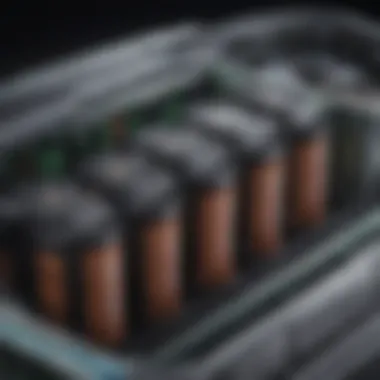Understanding Essential Efoil Parts and Their Functions


Intro
Efoils have revolutionized the water sports scene, providing a unique blend of environmental fun and thrilling adventure. These electric surfboards, with their lift-generating hydrofoils, genuinely redefine how enthusiasts engage with water. But what exactly makes them tick? Understanding the essential parts of an efoil not only enhances your riding experience but also empowers riders to maintain and troubleshoot their equipment more effectively.
In this guide, we’re diving deep into the core components of efoils, unraveling the functions that keep them gliding over water. From the thrilling propulsion systems to the intricate electronic controls, each part plays a pivotal role in the user experience. Whether you’re a seasoned pro or a novice looking to jump into the efoil world, gaining insight into these essential components is both enlightening and essential.
Get ready to explore the latest gear insights, uncover maintenance tips, and delve into the techniques that make efoiling such a captivating sport.
Preface to Efoils
Understanding efoils isn't just about the thrill of gliding over water with electric propulsion; it's about grasping the myriad components that make this exhilaration possible. For kiteboarders, instructors, and enthusiasts alike, recognizing what lies beneath the surface—so to speak—is vital. With the growing popularity of efoils, a deeper insight into their anatomy is essential for anyone serious about this sport.
The relevance of this topic extends beyond mere mechanics. Knowledge of efoil parts and their functions can significantly enhance performance and safety. Understanding how each component interacts allows riders to appreciate the balance of technology and design at play. Essentially, this knowledge helps individuals choose the right equipment, troubleshoot issues effectively, and even prolong the lifespan of their gear. It's about being informed—not just a thrill-seeker skimming the surface.
What is an Efoil?
An efoil, in simple terms, is a surfboard outfitted with an electric motor and hydrofoil. This combination allows riders to emerge from the water, creating a sensation akin to flying. Riders stand on the board, and as the motor propels it forward, the hydrofoil lifts the board upwards, reducing friction and allowing for gliding at high speeds.
Efoils typically come equipped with a remote control for effortless acceleration and deceleration. This control enables riders to navigate through water with a user-friendly experience. For many, the allure of the efoil lies in its ability to transcend the limitations of wind conditions or wave heights. When you’re flyers instead of floaters, the thrill is palpable.
History and Development of Efoils
The journey of efoils traces back to the amalgamation of surfing culture and technological advancement. The concept gained momentum in the early 2010s when inventors started marrying traditional surfing with motorized propulsion. Unless you’ve been living under a rock, you’ve probably noticed how this new wave sport has captured the imagination of water sports enthusiasts.
Pioneering efoil designs emerged from inventors aiming to improve water sports accessibility. Early models faced considerable challenges concerning battery life, motor efficiency, and control. However, persistence in research and development has led to significant strides over the years.
Today, efoils are characterized by slick designs and robust performance. Materials like carbon fiber and advanced composite technology have become standards for both strength and weight reduction. The evolution of battery technology has also played a crucial role. Where early efoils struggled with short rides, contemporary batteries now support longer outings without the dreaded mid-ride shutdown.
As innovations continue to unfold, the efoil’s legacy is still being written. Each advancement holds promise not just for performance but also for greener practices in water sports.
Core Components of Efoils
Understanding the core components of efoils is pivotal for anyone involved in the sport, whether they are beginners or seasoned riders. Each element in an efoil's construction plays a vital role in its performance and safety. This section will explore these components, emphasizing the benefits, considerations, and the specific functions they perform.
Hull and Design Aspects
Material Types
Choosing the right materials for the hull is a game changer when it comes to efoils. Materials like fiberglass and carbon fiber are commonly used, each offering unique pros and cons. For instance, carbon fiber is known for its lightweight and strength, which ensures not just agility but also durability under stress. On the flip side, fiberglass can be heavier, but it typically comes at a lower cost and provides a smoother surface that can enhance speed on the water.
Unique Feature: Carbon fiber allows for a higher strength-to-weight ratio, which contributes to better performance. However, its cost can be a downside for entry-level users.
Aerodynamics and Stability
The shape of the hull greatly influences the aerodynamics of the efoil. A well-designed hull minimizes drag, allowing the rider to glide effortlessly over water. This aerodynamic design contributes to stability, which is essential for maintaining control at high speeds. A lower center of gravity and streamlined design help resist tipping and rolling, making the ride smoother.
Key Characteristic: Good aerodynamics can lead to higher speeds and reduced fatigue for the rider. However, achieving this design can require extensive testing and adjustment, as stability can be compromised in poorly designed models.
Propulsion System
Electric Motor Specifications
The electric motor is the heart of the efoil, converting electrical energy from the battery into propulsion. Common specifications include wattage, RPM, and efficiency ratings. A high-watt motor will typically provide more thrust, allowing for quicker accelerations and maintaining speed against tides or wind.
Unique Feature: Efficiency ratings matter because they determine how long you can ride before needing a recharge. A balance between power and efficiency is crucial for a satisfying experience.
Propeller Dynamics
The propeller's design impacts both thrust and noise level. Different pitch and diameter can create various performance dynamics. A larger propeller may create more thrust but come at the cost of increased drag. Conversely, a smaller propeller gives you speed but might not pull as hard.
Key Characteristic: The dynamics of the propeller must align with the motor specifications for an optimal experience. Disproportionate collaborations can lead to inefficiency, affecting ride quality.


Foil Assembly
Types of Foils
Foil types significantly influence how the efoil rides. There are primarily two types: high-aspect and low-aspect foils. High-aspect foils are known for speed and efficiency, while low-aspect foils offer more stability and are often easier for beginners to manage. This choice affects the lift and maneuverability of the efoil.
Unique Feature: High-aspect foils lift the board quickly out of the water, reducing drag and allowing for thrilling speeds. Alternatively, low-aspect foils provide a gentler learning curve but might limit top speed.
Lift and Drag Considerations
The balance of lift and drag is key to an enjoyable efoil experience. Lift allows the board to rise above the water, while drag pulls against the motion of the board. Understanding this relationship helps in tuning the foil for optimal performance. More lift can lead to faster speeds, but if drag isn’t managed, it could hinder that speed.
Key Characteristic: Achieving the right lift-to-drag ratio is crucial for maximizing efficiency and speed. Poor management can lead to instability, making it difficult for the rider to control the efoil effectively.
Electronic Systems in Efoils
When it comes to efoils, electronic systems are the unsung heroes at the heart of their functionality. They ensure that all the moving parts work in harmony, amplifying the rider's experience. This section will delve into two main components: battery technology and control systems. Understanding these systems isn't just a technicality; it's key to maximizing performance and ensuring safety.
Battery Technology
The lifeblood of any efoil is its battery. Without a robust and reliable power source, an efoil is just a fancy board floating on water.
Battery Types and Lifespan
Efoils typically use lithium-ion batteries due to their excellent energy density and longevity. This type of battery can last for hundreds of cycles before showing significant wear, making it a smart choice for prolonged use. However, there's more to the story.
Lithium-polymer batteries are another alternative; they are lighter but may degrade faster compared to lithium-ion types. Each type affects how long you can ride and how much power you have.
The lifespan of a battery is contingent on various factors, including charging habits and usage patterns.
Key characteristics that stand out:
- High energy density
- Minimal weight
While lithium-ion batteries are reliable, their sensitivity to extreme temperatures can lead to reduced performance if not managed correctly. Riders often find themselves wondering how to prolong their battery's life, and environmental factors play a critical role in that.
Charging Practices
Next on the agenda is charging practices. Properly charging your efoil's battery is critical not just for performance but also for safety. Efoils often employ smart charging systems that optimize the voltage and current fed to the battery.
A good practice is to charge your battery after every session instead of waiting until it’s completely drained. This not only extends the lifespan but also ensures you're ready to roll at a moment's notice.
Unique features of charging practices include:
- Intelligent charging to prevent overloading
- Battery management systems that track health indicators
Keeping up with these practices might seem tedious, but neglecting them could result in diminished battery life or, worse, failure mid-ride.
Control Systems
Control systems serve as the brain behind your efoil, and they significantly affect both the riding experience and safety. They encompass everything from remote control functionality to advanced smart technologies.
Remote Controls
Remote controls for efoils often feature intuitive designs that make controlling speed or stopping the board a breeze. Most remotes include a trigger for acceleration, along with a safety kill switch— a must-have to ensure the rider's immediate control.
The key distinguishing characteristics:
- Ergonomic design
- Immediate responsiveness
The simplicity of remote controls cannot be understated. They allow for quick adjustments, putting the rider in full command of their speed and trajectory. This reliability fosters confidence, especially for newcomers to the sport.


Smart Technologies
Innovations in smart technologies are taking control systems to the next level. While basic remotes are functional, smart controls interface with mobile apps, providing real-time data about speed, battery life, and even GPS tracking.
This type of technology represents a significant leap forward as it can alert riders to firmware updates, performance statistics, and battery health—all conveniently accessible via a smartphone.
The advantages of these systems are many, but it also comes with a pinch of complexity that might deter some users from fully utilizing their capabilities. Still, the ability to mini-monitor performance metrics will likely appeal to those who revel in analytics.
"In today's age, having a finger on the pulse of your equipment is just as important as knowing how to handle it."
Ending
The electronic systems within efoils are not merely accessories but integral components that define the aspect of performance and safety. From high-quality battery technology to sophisticated control interfaces, understanding these elements is crucial for anyone serious about riding efoils. By mastering the intricacies of these systems, riders can make informed choices, thereby enhancing their overall experience on the water.
Safety Features and Considerations
When venturing into the world of efoils, prioritizing safety goes hand in hand with ensuring an exhilarating experience on the water. Each ride carries certain risks, and the unpredictable nature of aquatic adventures means that some precautionary measures are not just advisable, they're essential. Having solid safety features can significantly minimize accidents and ensure riders can harness the thrill of efoiling without compromising their well-being.
Emergency Shutdown Systems
An emergency shutdown system is a crucial feature in any efoil. Designed to deactivate the efoil's propulsion instantly, this system provides a vital safety net for riders. If a rider encounters sudden turbulence or feels overwhelmed, a quick press of the emergency button can bring the board to a halt.
The main benefit of this system is the reduction of accidents caused by losing control. For instance, if a rider inadvertently veers toward a rocky area or if the board starts behaving erratically due to a technical glitch, this mechanism can stop the efoil before harm can occur. Riders can focus on enjoying the ride, knowing they have a fail-safe at their fingertips.
Wearable Safety Gear
Helmets
Helmets are an important piece of wearable safety gear in the realm of efoiling. It’s easy to underestimate their significance while zipping through the waves, but a sturdy helmet can provide crucial protection in the event of falls or collisions. Riders of all skill levels can benefit from wearing one, as it shields the head against impacts that may occur unexpectedly.
A noteworthy characteristic to highlight is the lightweight materials used in modern helmets, ensuring that comfort doesn’t take a backseat to safety. Many of these designs feature ventilation systems to keep the wearer cool while riding. However, not every helmet is created equal; some might lack impact resistance, making it essential for riders to choose a model that meets industry standards.
Overall, it’s better to be safe than sorry, and wearing a helmet signifies a responsible approach to efoiling that can save against potential injuries.
Life Vests
Life vests are another non-negotiable aspect of safety gear when efoiling, often regarded as essential for novices and seasoned riders alike. They are designed to keep an individual afloat, especially in unexpected situations like wipeouts or equipment failures. The buoyancy offered by life vests can be a lifesaver, literally.
A standout feature of contemporary life vests is their streamlined design, which prioritizes mobility without sacrificing safety. Many vests are made from quick-drying materials and are even equipped with additional pockets for small essentials. However, it’s critical to choose a vest that fits well—too loose, and it won't provide adequate flotation; too tight, it hampers movement.
Ultimately, the peace of mind that comes from knowing one has the right life vest can enhance the overall enjoyment of the ride, allowing riders to focus on the thrill rather than worry about floating back after a tumble.
In summary, ensuring safety features such as emergency shutdown systems, helmets, and life vests not only strengthens the overall efoiling experience but also fosters a culture of responsible riding that prioritizes well-being.
Maintenance and Care for Efoils
Taking care of your efoil isn’t just a task; it’s a fine art that speaks volumes about a rider's commitment to performance and longevity. Just like a surfer checks the waves, an efoil owner needs to keep a keen eye on their setup. Proper maintenance ensures you can glide along the water smoothly, harnessing every ounce of fun that these machines offer. Without the right care, performance can dip significantly, leading to unnecessary repairs or, worse, accidents.
Key aspects of maintenance revolve around regular inspections and storage practices that keep your efoil in tip-top shape. These checks help in identifying potential hiccups before they turn into major headaches. Keeping up with routine checks and proper storage leads to better performance and prolongs the life of various components.
Routine Maintenance Checks
Motor and Battery Inspection
At the heart of your efoil lies the electric motor and battery, which are critical for ensuring you get the best performance while zipping across water. A focused examination of these elements is paramount. Regularly inspecting both the motor and battery not only helps in identifying wear and tear, it also maximizes efficiency.
Key characteristics include:
- Battery Health: Make sure the connections are clean and there’s no corrosion that could hinder performance. A well-maintained battery can drastically extend the lifespan, keeping those rides worry-free.
- Motor Functionality: Listening for odd sounds or vibrations can reveal troubles brewing beneath the surface. A smooth operation is what you want; any deviation might just be a signal of potential issues.
One unique feature of regular inspection is that it allows you to catch issues while they’re small. This means you might avoid costly repairs down the line. However, neglecting this part of maintenance can lead to catastrophic problems, such as reduced speed or even complete failure.


Foil and Hull Care
Your foil and hull are the parts that actually interact with the water, so how well you care for them can change the game entirely. Keeping the foil clean and free from dents and scratches greatly affects lift and performance.
Key aspects to consider include:
- Foil Maintenance: Regularly check for any signs of damage. Dings or scratches can disrupt water flow and affect glide, leading to a less efficient ride.
- Hull Care: Just like waxing a surfboard, maintaining a smooth hull surface is vital. Use a gentle cleaner to remove grime; this not only looks good, but it also supports optimal hydrodynamics.
The uniqueness of foil and hull care lies in its immediate impact on performance. After a thorough cleaning, many riders find a noticeable difference in how their efoil behaves on the water. Any neglect, on the other hand, might lead to disappointing outings filled with drag and reduced speed.
Storage Best Practices
Proper storage can be the unsung hero of care, ensuring your efoil doesn't suffer from environmental factors that can lead to premature wear.
Here are some must-follow tips:
- Dry Storage: Keep your efoil stored in a dry, shaded location when not in use. Sunlight and moisture can wreak havoc on the electronic components.
- Remove the Battery: Storing your battery separately can also help conserve its lifespan. Try to keep it charged within recommended levels to avoid deep discharges.
Remember, just like a fine wine, an efoil improves with proper care and attention. As you dive deeper into the thrilling world of water sports, make sure you give your equipment the love it deserves.
By adhering to these checks and practices, you're paving the way for many memorable adventures ahead.
Innovations in Efoil Technology
Innovations in efoil technology are reshaping the way enthusiasts engage with water sports. As companies strive to enhance performance and user experience, various advancements have emerged, from novel materials to sophisticated battery life improvements. These innovations not only play a crucial role in performance but also influence the overall accessibility and enjoyment of efoiling.
Emerging Trends
New Materials
Lightweight yet strong: The development of new materials has brought a significant change in the construction of efoils. Materials like carbon fiber and advanced thermoplastics are becoming popular choices. They are not just durable, but also incredibly lightweight, which is important for enhancing agility and performance on the water.
Key characteristic of these materials is their strength-to-weight ratio. This makes efoils easier to handle, particularly for beginners who are just getting the hang of balancing and maneuvering.
The unique feature of these new materials is their ability to resist corrosion and damage from saltwater, extending the lifespan of the components. However, while they are often more resilient, they can also come at a higher cost compared to traditional materials.
Improved Battery Life
Extended ride times: Improved battery life in efoils represents another leap forward, making the activity more enjoyable for beginners and seasoned riders alike. Recent advancements in lithium-ion and lithium polymer technologies have led to batteries that not only charge faster but also provide longer ride durations.
One of the key characteristics of modern batteries is their energy density. A higher energy density allows for more extended rides without adding extra weight, which can be a game-changer, especially in competitive settings.
The unique feature here lies in smart battery management systems that monitor usage, optimize charging, and enhance the efficiency of the power output. As beneficial as these improvements might be, it’s worth noting that they can still be sensitive to extreme temperatures, which may necessitate caution during storage and use.
Future Developments
Looking ahead, efoil technology continues to promise exciting developments, driven by ongoing research and customer feedback. Highly anticipated innovations include automated stabilization systems that could further enhance safety, and improved solutions for eco-friendly energy sources.
With each passing season, the efoil community has much to look forward to, and staying informed about these trends will only enrich one’s experience on the water.
Finale and Recommendations
In wrapping up our exploration of efoil components, it’s crucial to reflect on how each part interplays within this remarkable machine. Understanding these elements is essential not only for efoil novices but also for seasoned riders looking to elevate their experience. The stakes can be high with safety and performance hinging upon the quality and compatibility of each part.
Choosing the Right Efoil Parts
Selection of efoil parts isn't just about brand names or aesthetics; it’s about functionality and durability. Each rider has a unique style and set of needs based on their skill level, local water conditions, and personal preferences.
- Compatibility is Key: Ensure parts work seamlessly with each other. Mismatched components could lead to performance issues or even safety hazards.
- Quality over Cost: Invest in high-quality materials. Fiberglass, for instance, might be appealing for its cost, but carbon fiber could offer better performance and durability in the long run.
- Consider Your Riding Style: If you prefer speed, choose a propulsion system tailored for quick acceleration. If you lean towards stability, select a foil suited for that purpose.
- Battery Capacity: Pay attention to battery types and their longevity. Different cells provide various discharge rates, which affects ride time.
- Research and Reviews: Look up forums or websites like Reddit or Facebook groups dedicated to efoils. Real-world insights from fellow riders can steer you toward great choices.
Final Thoughts
The world of efoils requires a balance of knowledge and intuition. As technology advances, so do the options available in terms of parts and performance enhancements. The key takeaway is to prioritize personal safety and the experience.
Understanding the intricacies of each component offers more than just technical know-how; it cultivates a deeper appreciation for the sport.
"The joy of riding an efoil lies not just in that fleeting moment of gliding across water; it’s in the harmony between rider and machine."
Whether one’s an instructor preparing for lessons or an enthusiast planning the next adventure, a solid grasp on efoil components leads to better choices and, ultimately, a more enjoyable experience on the water. With the tips and insights covered in this article, riders can venture forth with confidence, knowing they’re well-equipped to handle their thrilling journeys.







